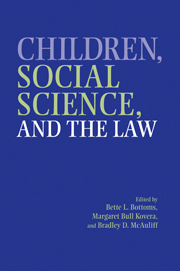Book contents
- Frontmatter
- Contents
- Acknowledgments
- Contributors
- 1 Children, Social Science, and the Law: An Introduction to the Issues
- PART I CHILDREN'S RIGHTS, THEIR CAPABILITIES, AND SOCIETY'S RESPONSIBILITIES TO CHILDREN
- PART II CHILDREN AND FAMILY CHANGE
- PART III JUVENILE AGGRESSION AND JUVENILE JUSTICE
- PART IV CHILDREN AS VICTIMS AND WITNESSES
- 12 The Effects of Community Violence on Children and Adolescents: Intervention and Social Policy
- 13 Preventing Child Abuse and Neglect
- 14 Children's Eyewitness Memory: True Disclosures and False Reports
- 15 Expert Testimony on the Suggestibility of Children: Does It Fit?
- 16 The Status of Evidentiary and Procedural Innovations in Child Abuse Proceedings
- PART V CONCLUSIONS AND FUTURE DIRECTIONS
- Author Index
- Case Index
- Subject Index
- References
16 - The Status of Evidentiary and Procedural Innovations in Child Abuse Proceedings
Published online by Cambridge University Press: 24 July 2009
- Frontmatter
- Contents
- Acknowledgments
- Contributors
- 1 Children, Social Science, and the Law: An Introduction to the Issues
- PART I CHILDREN'S RIGHTS, THEIR CAPABILITIES, AND SOCIETY'S RESPONSIBILITIES TO CHILDREN
- PART II CHILDREN AND FAMILY CHANGE
- PART III JUVENILE AGGRESSION AND JUVENILE JUSTICE
- PART IV CHILDREN AS VICTIMS AND WITNESSES
- 12 The Effects of Community Violence on Children and Adolescents: Intervention and Social Policy
- 13 Preventing Child Abuse and Neglect
- 14 Children's Eyewitness Memory: True Disclosures and False Reports
- 15 Expert Testimony on the Suggestibility of Children: Does It Fit?
- 16 The Status of Evidentiary and Procedural Innovations in Child Abuse Proceedings
- PART V CONCLUSIONS AND FUTURE DIRECTIONS
- Author Index
- Case Index
- Subject Index
- References
Summary
Prosecuting physical and sexual crimes allegedly perpetrated against children is a complex and difficult task. Often the sole eyewitness to the crime is the abused child. As a result, the successful prosecution of many child abuse cases hinges on the child victim's account of the crime. Testifying in court can be stressful for any witness, particularly for child victims of physical or sexual abuse (Goodman et al., 1992). Several features of traditional trial proceedings, such as facing the accused or describing the details of the alleged crime in open court, may make children reluctant to testify about their abuse (Sas, 1991) and may decrease the accuracy of their testimony (Saywitz & Nathanson, 1993).
Various evidentiary and procedural innovations have been introduced over the past decade to help enable victims to testify in child abuse proceedings. At the federal level, for example, the Victims of Child Abuse Act of 1990 (§3266) amended the Federal Rules of Criminal Procedure, extending special accommodations to children such as allowing the presence of a support person during the child's testimony and closing the courtroom to the public (Whitcomb, 1992). Many states have enacted statutes permitting the use of innovative procedures, such as videotaped or closed-circuit television (CCTV) testimony, in trials involving alleged child abuse victims. Those innovations are examples of a broad spectrum of alternatives to traditional testimony that were designed to reduce the stress associated with appearing in court and to increase the accuracy of children's testimony.
- Type
- Chapter
- Information
- Children, Social Science, and the Law , pp. 412 - 446Publisher: Cambridge University PressPrint publication year: 2002
References
- 6
- Cited by



